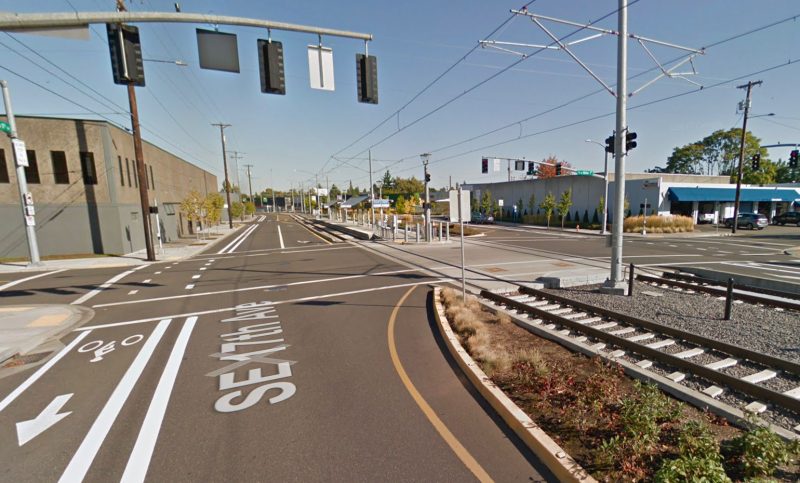
We’ve received preliminary details about a collision this afternoon between a bicycle rider and a MAX operator.
According to TriMet it happened on the MAX Orange Line near SE 17th and Rhine. Rhine is a busy bicycle corridor because it’s the street used to access the Lafayette Street Bridge over the railroad tracks.
Portland Police say the bicycle rider was an adult male and has been transported to a hospital with “what are believed to be non-life-threatening injuries” (which can be a very wide range of severity). The collision is still under investigation and we’ll update this post as we learn more.
— Jonathan Maus: (503) 706-8804, @jonathan_maus on Twitter and jonathan@bikeportland.org
Never miss a story. Sign-up for the daily BP Headlines email.
BikePortland needs your support.


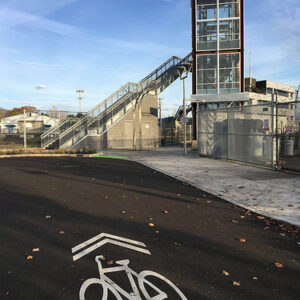
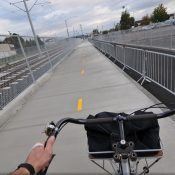
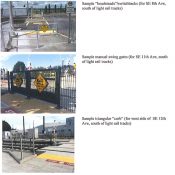
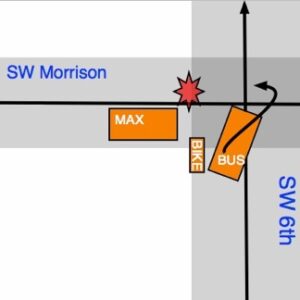
Thanks for reading.
BikePortland has served this community with independent community journalism since 2005. We rely on subscriptions from readers like you to survive. Your financial support is vital in keeping this valuable resource alive and well.
Please subscribe today to strengthen and expand our work.
It was bound to happen eventually. The design of the bike path along the MAX tracks is dangerous and confusing. It creates conflict between modes, encourages cyclists and walkers to ignore the perpetually-running train signals, and doesn’t give cyclists a clear area where they are supposed to be riding or make obvious which signals they are supposed to pay attention to.
One of the (many) things that bother me about this area is how the bike signal light is separate from the walk signal light, which is separate from the gates-down/a-train-is-coming-light. There is even one spot where, if you pull too far forward (to a reasonable place on the curb), you can’t even see if the bike crossing light is green.
None of this is to say the biker didn’t just disregard common sense safety and cross the tracks in a game of chicken (no details yet) but, yes, this area could really use some work. You deal with this mess enough times and your makeshift solutions seem reasonable and safe after a while.
Is it confusing to look both ways before crossing an active rail line? I was taught to do that when I was 3.
Of course it’s common sense to look both ways when crossing a rail line, same as crossing the street. But it doesn’t help that the train signals seem to go on far too early and stay on far after the train has passed. I’ve even seen them stuck on before with no train in sight. There are too many signals going on all at once and too much inconsistency: sometimes you follow the bike signal, sometimes the ped signal; sometimes you ride on a sidewalk, sometimes in the street with a sharrow and sometimes with a green lane. It’s all very confusing and inconsistent and these are a recipe for danger. When cyclists don’t know what to do, they just do whatever they want. There should have been a clear cycle-only path with consistent street and rail crossings, not a mishmash of half-assed bike improvements, “bikes on sidewalks,” and shared lanes..
Isn’t common sense a prerequisite for riding bikes?
Was that a rhetorical question?
not in a city that give the tiniest @#$& about human life. people walking or rolling should be expected to survive “mistakes”.
Really? All mistakes? Step in front of a bus, ride into a MAX train, and it isn’t allowed to hurt?
did i write “all”?
does my use of “expectation” suggest a black vs white position?
btw, the premise that we can design roadways that facilitate the survival of people walking or biking is the basis of vision zero. as far as i can tell, many people who post on bike portland do not believe this premise. i sometimes wonder whether people who predominantly bike for transportation are more opposed to vision zero than people who drive for transportation…
Yes, your post suggests a very black and white position. Either trains should be operated in a way that people should expect to survive collisions, or the city doesn’t give even the tiniest bunch of punctuation for human life.
There’s not much room for nuance there.
Hello, kitty claimed that my use of “expectation” did not leave “much room for nuance”
Synonyms of “expectation”: supposition, assumption, presumption, conjecture, surmise, calculation, prediction, hope.
Strawman!
How would you suggest TriMet operate its trains so that a collision with a cyclist is not dangerous? Lower speeds to 15mph? I want transit to be fast and efficient, because I want people to use it.
One solution is to make the signals work better so that when the signal is red, it means the train is really, truly coming, and you better pay attention because we’re not kidding, it really is coming. Now it means there might be a train coming sometime in the future, or maybe it came through a while ago, or well, maybe, the train might actually be here, but it’s probably yet another false alarm.
Right, consistency in the train signals would greatly help; since they seem to go on for no reason, this fosters an attitude where people feel comfortable ignoring them. Automatic crossing gates for the bike path would cut back on illegal crossings too, although you could still technically sneak under them. Better would have been to elevate the MAX tracks so that we wouldn’t have had this problem in the first place and wouldn’t need to build overcrossings and complicated zigzagging paths, but it’s obviously too late for that.
Common sense is a per-requisite for adulthood, so yes. Still, some people lack this common sense, and end up learning the hard way.
even human beings with “common sense” (an ill-defined term often used to demean) make mistakes.
This is a great point actually. Human cognition is limited, it is easy to be momentarily distracted, and when people have been habituated to ignore the warning signals, tragedy can happen.
This has nothing to do with “common sense”.
which is why i started this comment thread by referring to “mistakes”. we all make them and we deserve planning, design, and infrastructure designed to mitigate our mistakes. several european nations have shown that this is 1) possible and 2) not as large a financial burden as detractors often claim.
I am curious to hear about such examples. Can you provide one or two?
To suggest that what is possible in Europe is therefore possible i the US does not recognize the inherent differences between the US and other countries.
did you even read the story and see where this occurred?
there’s no confusion to be had at this crossing… either you’re in the lane following the light or you’re on the sidewalk following the ped signal… there’s nothing confusing about it at all… there’s no special bike signal… you wait for the red to go away and then you go across…
Good point. On SW 1st at Ankeny St. there is no crossing signal for pedestrians, bikes, or cars. Two blocks away at Pine St. the crossing signal goes to red before the train even starts rolling. I guess it’s the weird mutant nature of MAX– is it a train, or a trolley?
It was bound to happen eventually because some people are too distracted to actually look up and down railroad tracks before crossing them.
Distracted or simply impatient and careless? I see all three–but I’m getting really sick and tired of willful scofflaw behavior, which seems to be worsening.
I hope the guy is truly ok. Not speculating on his behavior, here.
Based on this statement, it sounds like you are free of scofflaw behavior. If true, that’d Be quite a controlled life you lead.
Trains only travel on train tracks; two possible directions. You have to be pretty careless to get hit by one
People go to great lengths to avoid admitting they did something stupid. This is true in both cycling and politics.
hmmmmmm…
people driving have dedicated train signals, dedicated train warning bells, and dedicated train crossing gates.
Are you suggesting he didn’t know the train was coming?
First off, there are truly dedicated signals for cyclists and peds that are not really visible to motorists. Secondly, the “dedicated” signals and bells are ceven more obvious to pedestrians and cyclists than motorists.
I have seen a lot of cyclists cross rails against signals over the years. I have yet to see a situation where it wasn’t obvious they didn’t know they were crossing against the signal. There was an article on BP not that long ago where cyclists climbed through a train.
Odds are overwhelming that this is a simple case of willfully reckless behavior. Pretending otherwise only helps perpetrate the perception of cyclists as unreasonable kooks.
I’d argue crossing against the light is a bad idea. However, I will admit to doing it a few times myself, because you can generally tell when the train is coming anyway regardless of the signal. The signals often come on far earlier than the train leaves the station, and trains are very easy to predict, so crossing against the light is generally not a huge deal if you are aware of your surroundings. If TriMet truly thinks people can not handle crossing an active rail line on foot or bike, then they should have added crossing arms to the sidewalks too.
That being said, this predictability regardless of signals makes it very difficult to actually get hit by a moving train, so I’d agree with you regarding the negligence on the cyclists part. You’d have to really mess up to get hit by a train. Plenty of peopel cross against the signals all the time and never have a problem.
i’m only pointing out the differences in safety infrastructure spending on different modes.
Given that the functional needs are totally different on both the micro and macro levels, these differences should be expected.
exactly! people walking or rolling are not enveloped in air-bags in metal boxes designed to disperse kinetic energy so more funding should be spent on relatively more inexpensive safety infrastructure.
So what does that have to do with a cyclist not paying attention to his environment? This has nothing to do with cars.
Many sections of the MAX line, including this one, have no gates for any users. I would think a cyclist, traveling at slower speeds without a giant steel cage to obscure their views or perceptions would have no trouble avoiding a train.
Even all those people in steel cages manage to negotiate these fairly well. And it they don’t we usually still blame them instead of the infrastructure.
The problem is that we are habituated to ignore the signals because they were so crappily implemented. It’s really worse than no signal at all.
…and we’re habituated to having the impulse control of perpetual toddlers. Impatient big babies who want what we want NOW, dammit!
Hope he’s okay. Before we blame the infrastructure, let’s find out why he rode into a train’s path. There are many distractions these days…
The bells and flashing lights would be extremely distracting…
My teen was running in the area and he said the collision was where the MUP crosses over the tracks just west of Rhine. As a daily user of this path, I’ve got to say this is actually a good crossing from a signal/sight lines perspective. Way better than crossing the car off ramp riding South East bound. Terrible thing regardless.
that’s 2 blocks away at Pershing… did they really get it THAT wrong?
also, there are a lot of flashing lights and bells at that crossing…
Sorry but that headline is just wrong!
Saying the bicyclist collided with a MAX train operator makes it sound like a pedestrian accident. I think it is safe to say MAX train was the object while discussing the accident. The vehicle is just too big. Just like you would not say “sea captain runs into dock” but, “ship runs into dock”
Kittens,
I hear you. And I agree it’s not perfect. I’m trying to add a human element to the subject of the MAX. I’ll keep tweaking it.
The problem with the language is that the vehicle here was a train. You can’t really argue that the train operator “drove into” the cyclist, because the train is on a track. “sea captain pilots ship into dock” would be appropriate for the example given above.
I changed it to “MAX train” which I still don’t think is perfect. My goal is to try and write in a way that accounts for the fact that these vehicles are not anonymous objects — and that the responsibility for what they collide with ultimately lies with the operator and not the vehicle itself.
“responsibility for what they collide with ultimately lies with the operator”
Not if the laws of physics disallow a train to decelerate in time to avoid a collision. Trains only move in straight lines, it’s not as if the train operator can avoid crashes like a car driver could. Even applying emergency brakes would result in injuring riders inside the vehicle.
In the case of trains, the fault is generally on the person getting hit, as it’s their responsibility to avoid a predictable, large, fast moving, on-rails vehicle. The operator literally cannot avoid collisions most of the time. That’s why train crossings are either grade-separated or have arms that prevent crossings.
I’ve watched BP headlines evolve over the years and as far as i can tell, these are the rules.
– All actions must be attributed to the human who is in control of the object, not to the object itself. Cars don’t collide with pedestrians, drivers do.
– All actions must be in the passive voice, lest active voice be interpreted to imply intent or fault. Cyclists don’t run into obstacles, there are collisions.
– The word “accident” is prohibited as it might imply absence of fault. The word “crash” is also banned, rationale unclear. Everything is a collision.
– The verb “to operate” and the noun “operator” is preferred “to drive” and “driver”. This seems to apply to all modes of travel involving powered equipment. Thus we are all operators, unless we are bike riders or pedestrians. It is unclear how ebike operators are to be referenced.
Therefore, the typical accident in Portland is
“A collision involving a motor vehicle operator and a pedestrian”
“A collision involving a bicycle rider and a MAX train operator”.
“A collision involving a pedestrian and a lamppost”.
Don’t forget, it is always the fault of the bigger vehicle. Even if the biker is drunk.
I know you’re just being sarcastic here, but did you know in more advanced nations (with sane bike and ped functionality) that is exactly the case? Motorists in The Netherlands are basically always legally held largely responsible for accidents with peds and cyclists – automatically. Yes, that includes drunk ones! Several things here; the recognition that a motorist in vicinity of cyclists and peds is inherently dangerous and the activity requires extreme vigilance. Then the one sided nature of potential damage and injuries. And the awareness of human (and even animal) nature that the bigger, faster and heavier thing or creature will almost intuitively or even unconsciously dominate the interaction – and this needs countering for a sane environment. Finally, it’s amazing how polite motorists get when they know if something happens they are gonna be on the spot! Yey!
Contrast that to here where all you have to do to legally kill someone is make sure they’re on a bike or walking, hit them hard and fast then say “I didn’t see em” This virtually always works even though if you hit another car it’s ever seen as an excuse. Only for bikes and peds… I know which system I’d like to live with.
If you follow the rules of the road, you should not be considered guilty of a crime in the event of a crash. Civilly liable, certainly, but not criminally. The right approach here is to change the rules of the road to reduce the likelihood of terrible outcomes when the rules are followed.
If engineers say it’s safe to drive 35MPH on an urban street, it’s hard to blame people for doing so.
Engineers also assume that drivers will be operating their vehicles with extreme care. Here’s a bit from the Oregon Drivers Manual:
Looking Ahead
It is important for drivers to scan ahead for trouble spots as far as you
can see to help you avoid the need for last-minute moves. Scanning
means taking in the entire scene, including the sides of the road.
Scanning the road ahead and to the sides helps you see pedestrians
ahead, potential hazards, vehicles that may enter your path, or signs
routing you to another street or road.
Look for clues that a driver ahead may be going to slow down or stop,
such as a bicyclist or pedestrian on the road ahead, brake lights coming
on, or blinking turn signals.
There are many, many other guidelines like this in the manual, which are regularly ignored by the drivers the engineers have designed the road for.
http://www.oregon.gov/ODOT/Forms/DMV/37.pdf
Do you believe engineers are so naive as to think drivers will follow every instruction in their training manual?
Of course not. Most drivers can’t be bothered to follow the rules that are on full display on the side of the road, much less live up to the guidelines they are supposed to follow from the drivers manual.
That exactly contradicts your previous post.
No, it contradicts your hyperbolic interpretation of my previous post.
This “z” style crossing of the tracks by the MUP has a very awkward and cramped design. It is poorly made and shoe-horned into the hardscaped path. I do not like crossing it by cycle, at all, especially when it is wet. It can be a bit challenging to see trains approaching from the west/north as they come around the bend from behind the raised wall with some speed, although trains coming from the south/east leaving the nearby Max stop are pretty easy to see. To see approaching trains, you either have to turn and look 180 degrees behind you, or maneuver to turn and immediately stop your bike in the very tight and cramped spacing allowed here (stopping very close to the rail tracks) so you can look to the left 90 degrees to see the train. If you have trouble cranking your neck 180 degrees while maintaining control of your cycle, this spot can be a bit tricky, by design.
or just look at the flashing red lights directly in front of you… or hear the chiming bells… no need to see a train when you’re being assailed with so many alarms…
I think there was good discussion above about the saturation of bells and lights, including the duration of these, to the point that they are less effective.
I guess I always perform 100% inspection for trains at this intersection, regardless of the status of the bells and lights. And, the design of this intersection makes this difficult. I guess I could make this easier for myself by just watching for the blinky lights instead of looking for actual trains (blind trust in the automated train signal systems). Do you ride through without looking for trains?
The crossing is awkward by design, to force people crossing to slow down and check for trains. Many people heading northbound bypass it by riding in the shoulder after the bike lane ends and then hopping onto the multiuse path at the crosswalk. This is really dangerous, and it was only a matter of time before someone got hurt doing it.
As for the signals, they start early to give people who move slowly enough notice to get off the tracks. If you ignore them, that’s on you. Same as ignoring stop lights or signs reading “Bump”.
And why do the bells keep ringing after the train has passed?
This becoming a vent post all, may I add that “collision… MAX… southeast” conjured images not at Rhine but on 12th, where someone chose the worst possible time to try portaging through stopped freight cars? I have seen at least one person do this at various times of day on literally every occasion I’ve been held up there.
Hopping through a stopped freight train is idiotic and suicidal. If the train starts moving while you’re on the couplings…dead. Especially stupid since there is a rail underpass along Powell just a half-mile further south along the bike path.
The access on 17th is abysmal. Its a mode share nightmare. Cross walks take 30 seconds for pedestrians, even though most navigate the road in 10 seconds. Its an incredibly frustrating mix of modes that preemptively forces vulnerable road users to wait for inordinate amounts of time. If you waited for every bike or ped signal here you would spend your life in these intersections. The defacto status quo is to run them all and look both ways. Perhaps the victim operates like these and didn’t look well.
I really don’t understand the sentiment, “I don’t know the details of the collision, but I can’t resist an opportunity to call someone stupid while they are lying in the hospital.”
How about, “I don’t know the details of the collision, but I’m certain it was caused by bad infrastructure and/or irresponsible operator of a large vehicle who should be charged?”
Yes, it would be valuable for you and others to thoughtfully consider the differences between these two statements. It would also be valuable to consider why one of these would resonate with you more than the other.
If you don’t know the detail of the collision than you can be certain of nothing. The first hand account posted last night refutes most assumptions made about this accident.
Time and again posts here about injured cyclists prompt s***-storm of comments about bad bike infrastructure without any knowledge of the cause of the accident.
The best thing you have to keep you safe is your brain. If you ride enough and gain enough experience you will become a safer rider because you have better skills and are able to make better decisions.
Infrastructure aids in reducing the decisions that you need to make but no matter where you ride, at some point you will need to share a road with a car (or train) so preparing for that is a necessary part of learning how to ride a bike.
And yet, it seems that neither of these was true in this case…
I saw this happen. I was in my car going northbound on 17th when I was stopped by the gate for the Max train to come through. After about 20 seconds, I saw the train slowly coming down the tracks getting close to the intersection, then saw a biker biking what seemed fairly slowly perpendicular to the train (biking northbound as well (I was at the curve starting to go west)). A second later confusion started to sink in that he was still biking towards the track with the train coming. Then I saw him casually (and I mean super casually like a jogger could have easily kept up or passed him) keep going over the tracks and then get hit. Endorphins instantly raced through me and I shouted out OH MY GOD, which shocked my wife (registered nurse and has worked in Behavioral Health) who was in the back seat with our 19 m/o son. She said WHAT HAPPENED and I said a biker just got hit by the max train and she said LET ME OUT! She ran to him and was the first on the scene. I stayed with my son. She said the biker just wanted to get up and said he had things to do and needed to go but she convinced him to not move a muscle and kept him down until an off duty fire fighter showed up to help and then shortly after a fire engine showed up. She said he was most likely on something but maybe just in shock and completely out of it from getting hit, maybe even just alcohol but he smelled quite bad, was wearing not so great clothes to put it nicely, and the bike was quite old and beat up as well (not just from this incident). Yes, there is a chance he could have been homeless. I really do hate making assumptions but perhaps it should be know to help piece the story together? Now I’m going to feel bad saying this if the guy is a good man who was just down on his luck having a rotten day and his shower hasn’t been working for days, but that was his current situation. Her description of him went along with my guess that he was on something because how could he have not seen the train coming with him going so slow and the train going quite slow too. It made no sense to me how that could happen. Seemed like there could have been a hundred signs, gates, bells, and lights and this guy still would have gotten through it all to finally meet the front of the train. I do hope to hear the final report about him. I’m so so glad he survived. Who knows what his situation is and I never look down on people that have been dealt a bad hand in life. I hope he comes out of this ok and has a good recovery. And looks both ways next time.
“It’s all very confusing and inconsistent and these are a recipe for danger.” As a year-round bike commuter for the past 10 years, I couldn’t agree more. It’s confusing & dangerous for cyclists & motorists.
I’ve already noticed too that some of the new bicycle infrastructure isn’t designed to handle the current amount of bike traffic in safe way.